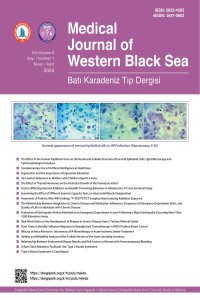Abstract
Amaç: Egzersiz kapasitesi, kardiovasküler durumdan, kas oksijenizasyonundan ve yardımcı solunum kaslarının fizyolojik özelliklerinden etkilenebilmektedir. Bu çalışmanın amacı, klinikte sık kullanılan artan hızda mekik yürüme (AHMYT) ve altı dakika yürüyüş (6DYT) testleri sırasında meydana gelen intercostal kas oksijenizasyonu değişimi ve hemodinamik yanıtlar üzerine etkilerini belirlemek, test başarılarını karşılaştırmaktır.
Gereç ve yöntem: Çalışmaya 18-35 yaş arası ve beden kitle indeksi <25 kg/m² olan sağlıklı bireyler dahil edildi. Katılımcılar randomize edilerek iki gruba ayrıldı. İlk gruba 6DYT, 2. gruba ise AHMYT yapıldı. 30 dakikalık arınma süresinden sonra gruplar çaprazlanarak, ilk gruba 6DYT ve 2. gruba AHMYT uygulandı. Uygulama süresince kas oksijenizasyonunu ölçmek için yedinci interkostal boşluğa yakın kızılötesi spektroskopi (MOXY) cihazı yerleştirildi. Solunum fonksiyon testi ile solunum fonksiyonları, modifiye Borg skalası ile dispne, taşınabilir tansiyon aleti ile kan basıncı, parmak oksmetresi ile kalp hızı ve oksijen saturasyonu değerlendirildi.
Bulgular: Olguların testler öncesi istirahat değerleri benzerdi (p>0,05). Testlerin, başlangıç ve bitiş saturasyon, kalp hızı, kan basıncı yanıtları, kas oksijen saturasyonu ve total hemoglobin miktarları benzerken, AHMYT bitiş kalp hızı değeri istatistiksel olarak anlamlı olmamakla birlikte daha yüksekti (p=.05). Benzer biçimde bitiş dispne seviyesi ve toplam test süresi AHMYT’de daha fazla (p<0,05), yürüme mesafesi ise 6DYT’de daha fazlaydı (p<.001).
Tartışma: 6DYT ve AHMY testlerinin sağlıklı olgularda oluşturdukları hemodinamik yanıtlar ve kas oksijenizasyonu değişimleri benzerdir. Olgular AHMYT’de daha fazla nefes darlığı hissetmekte ve kalp hızı yanıtları daha fazla olabilmektedir. Diğer taraftan AHMYT’de daha uzun sürelerde yürümelerine rağmen, 6DYT’de daha uzun mesafelerde yürüyebilmektedir.
Keywords
Altı dakika yürüme testi artan hızda mekik yürüme testi interkostal kas oksijenizasyonu kas oksijenizasyonu MOXY
Ethical Statement
Çalışmamıza Sağlık Bilimleri Üniversitesi Hamidiye Bilimsel Araştırmalar Etik Kurulu tarafından 19.01.2024 tarih ve 23/685 sayı ile etik kurul onayı alınmıştır.
Supporting Institution
Tübitak
Thanks
Çalışmamıza ’’TÜBİTAK 2209-A üniversite öğrencileri Araştırma Projeleri Destekleme Programı’’ kapsamında destekleyen TÜBİTAK’a teşekkür ederiz.
References
- 1. Koyuncu O. Egzersiz Kapasitesini Etkileyebilecek Hastalığı Bulunmayan Erişkin Bireylerde 6 Dakika Yürüme Testi ve Kalp Hızı toparlanma zamanının referans değerlerinin belirlenmesi Uzmanlık Tezi,Uludağ Üniversitesi, 2020.
- 2. Dilektaşlı A. 2019. Kardiyopulmoner Egzersiz Testleri ve Alan Testleri. Güncel Göğüs Hastalıkları Serisi, 2019; 7 (1): 26-38
- 3. Şen E. Egzersiz Fizyolojisi ve Egzersiz Testleri. Toraks Cerra hisi Bülteni, 2017; 10: 29-36
- 4. Ceylan E. Kardiyopulmoner egzersiz testleri. Journal of Clinical and Experimental Investigations ,2014; 5 (3): 504-509
Abstract
Objective: Exercise capacity can be affected by cardiovascular status, muscle oxygenation and physiological properties of accessory respiratory muscles. The aim of this study is to determine the effects of intercostal muscle oxygenation changes and hemodynamic responses during the increased speed shuttle walking (ISWT) and six-minute walk (6MWT) tests, which are frequently used in the clinic, and to compare the test successes.
Materials and methods: Healthy individuals between the ages of 18-35 and with a body mass index <25 kg/m² were included in the study. Participants were randomized and divided into two groups. 6MWT was performed on the first group and ISWT was performed on the second group. After the 30-minute washout period, the groups were crossed and 6MWT was applied to the first group and ISWT was applied to the second group. A near-infrared spectroscopy (MOXY) device was placed in the seventh intercostal space to measure muscle oxygenation during the application. Respiratory functions were evaluated with a pulmonary function test, dyspnea with the modified Borg scale, blood pressure with a portable sphygmomanometer, heart rate and oxygen saturation with a finger oximeter.
Results: The resting values of the cases before the tests were similar (p>0.05). While the initial and final saturation, heart rate, blood pressure responses, muscle oxygen saturation and total hemoglobin amounts of the tests were similar, the ISWT final heart rate value was higher, although not statistically significant (p = .05). Similarly, the end dyspnea level and total test time were higher in ISWT (p<0.05), and the walking distance was longer in 6MWT (p<.001).
Discussion: The hemodynamic responses and muscle oxygenation changes produced by 6MWT and ISWT tests in healthy subjects are similar. Patients feel more shortness of breath and heart rate responses may be greater in ISWT. On the other hand, although they walk for longer periods in ISWT, they can walk longer distances in 6MWT.
Keywords
Intercostal muscle oxygenation MOXY muscle oxygenation shuttle walk test at increased speed six minute walk test
References
- 1. Koyuncu O. Egzersiz Kapasitesini Etkileyebilecek Hastalığı Bulunmayan Erişkin Bireylerde 6 Dakika Yürüme Testi ve Kalp Hızı toparlanma zamanının referans değerlerinin belirlenmesi Uzmanlık Tezi,Uludağ Üniversitesi, 2020.
- 2. Dilektaşlı A. 2019. Kardiyopulmoner Egzersiz Testleri ve Alan Testleri. Güncel Göğüs Hastalıkları Serisi, 2019; 7 (1): 26-38
- 3. Şen E. Egzersiz Fizyolojisi ve Egzersiz Testleri. Toraks Cerra hisi Bülteni, 2017; 10: 29-36
- 4. Ceylan E. Kardiyopulmoner egzersiz testleri. Journal of Clinical and Experimental Investigations ,2014; 5 (3): 504-509
Details
| Primary Language | Turkish |
|---|---|
| Subjects | Exercise Physiology |
| Journal Section | Research Article |
| Authors | |
| Publication Date | April 30, 2025 |
| Submission Date | May 10, 2024 |
| Acceptance Date | March 2, 2025 |
| Published in Issue | Year 2025 Volume: 9 Issue: 1 |


